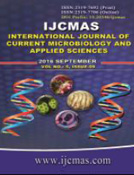


 National Academy of Agricultural Sciences (NAAS)
National Academy of Agricultural Sciences (NAAS)

|
PRINT ISSN : 2319-7692
Online ISSN : 2319-7706 Issues : 12 per year Publisher : Excellent Publishers Email : editorijcmas@gmail.com / submit@ijcmas.com Editor-in-chief: Dr.M.Prakash Index Copernicus ICV 2018: 95.39 NAAS RATING 2020: 5.38 |
Infection with EBV virus is a frequent event. However, the reason why it has the ability to exert an oncogenic impact on some individuals while sparing others remains poorly understood. Studies revealed a heterogeneous prevalence of the association of EBV and BC in different localities. Most of these studies were in Western countries and the USA. These studies couldn’t explain the difference. We are trying to predict whether an association of EBV and the BC is present in our locality. Eighty subjects were enrolled in the study; 40 patients (with BC) and 40 age and sex matched controls. All the participants’ breast and blood specimens were subjected to Rt-PCR assay, EBNA-1 immuno histochemistry and EBNA-1 IgG assessment by ELISA. Twenty (50%) patients with BC were positively detected by IHC of EBNA-1 while, no cases were detected in the control group, (P- value; <0.05); Thirty (75%) patients with BC were positive for EBNA-1 gene by Rt-PCR, whereas, only 10 (25%) had this gene in the control group, (P- value; <0.05). Twenty five (62.5%) patients with BC were positive by ELISA while, only 3 cases (7.5%) were positive in the control group, (P- value; <0.05). EBV was more frequent in BC cases than in the controls and in the invasive than the non-invasive histopathological grades of BC cases. The association of EBV with BC was frequent in younger age groups. Rt-PCR was more sensitive and specific than IHC and ELISA in assessment of EBV presence. A larger number of cases and healthy controls with different, ages, races and localities and with a combination of different assays is recommended for evaluating EBV association with BC.
 |
 |
 |
 |
 |